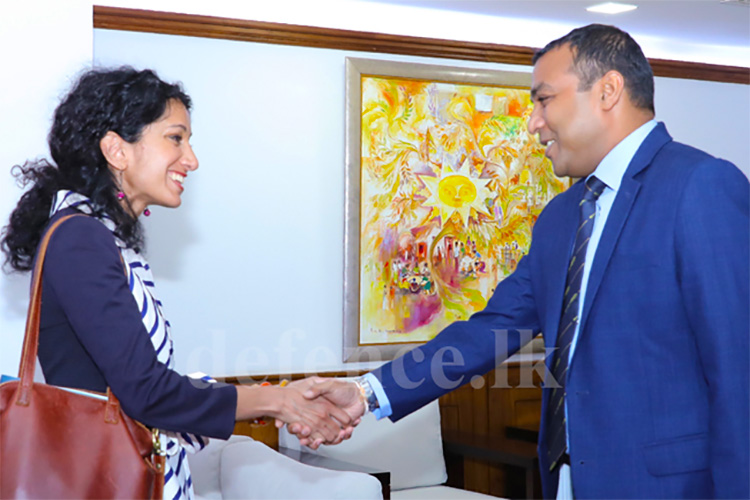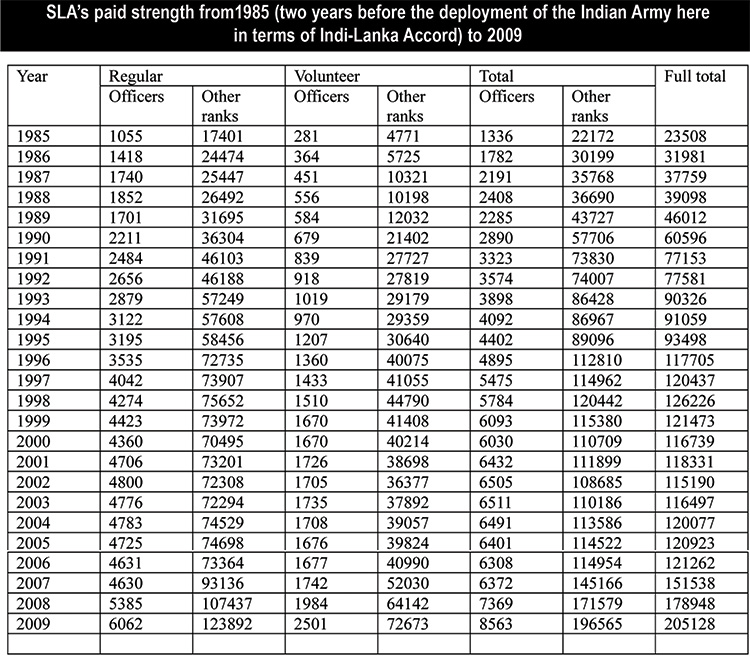SPECIAL REPORT : Part 471
Assurance to US on the size of military
By Shamindra Ferdinando
The Defence Ministry recently quoted State Defence Minister, Pramitha Bandara Tennakoon, as having assured US State Department official, Afreen Akhter, that the military would be ‘right-sized’ to perform their classic role.
The assurance was given on 15 May at his office, in Colombo, just ahead of the14th anniversary of Sri Lanka’s triumph over the Liberation Tigers of Tamil Eelam (LTTE), when our security forces brought the war to a successful conclusion, on the morning of 19 May with the Vijayabahu Infantry Regiment (VIR) troops wiping out a small group of hardcore LTTE cadres, on the banks of the Nanthikadal lagoon. Among the dead was LTTE leader Velupillai Prabhakaran.
Why did the State Defence Minister make such a pledge? Did Akhter, the Deputy Assistant Secretary, South and Central Asia Bureau of the State Department, seek a clarification as regards security sector reforms? If the military had continued to perform their classic role of being a ceremonial Army, the LTTE could have achieved Eelam. But the nearly three-year long sustained offensive brought the LTTE to its knees, 14 years ago.
Afreen Akhter oversees Sri Lanka, Bangladesh, Bhutan, and the Maldives, as well as the Office of Security and Transnational Affairs.
Her visit was the first by a State Department official, since National Freedom Front (NFF) leader, Wimal Weerawansa, last month alleged, in a published book ‘Nine: The Hidden Story;, that the US had a direct role in the removal of President Gotabaya Rajapaksa last year. The former industries minister is on record as having disclosed that US Ambassador here, Julie Chung, personally offered Speaker Mahinda Yapa Abeywardena an opportunity to succeed Gotabaya Rajapaksa, regardless of constitutional impediment, to bypassing Ranil Wickremesinghe, in an unannounced visit to his official residence.
Ambassador Chung swiftly rejected the allegation made no sooner ‘Nine: The Hidden Story’ was launched at the Sri Lanka Foundation on 25 April. However, Speaker Abeywardena gave credence to lawmaker Weerawansa’s shocking claim by remaining dead silent.
Since the conclusion of the war, the Mahinda Rajapaksa government quietly began downsizing the SLA, which was little above 200,000 at the height of the war. However, the present government officially acknowledged the downsizing of the war-winning, Army on 13 January, 2023. State Minister Tennakoon was quoted as having said that the SLA strength would be further reduced to 135,000 by the end of next year and 100,000 by 2030.
Of course there cannot be an issue over the need to gradually decrease military strength in peace time, taking into consideration post-war national security requirements and the pathetic economic situation, confronting the country.
Regardless of the developing political-economic-social crisis, it would be the responsibility of the military top brass to brief the political leadership of the ground situation. Post-war national security requirements shouldn’t be looked at only on the basis of economic indicators. That would be suicidal. In other words, the country is in such a precarious situation, political leadership may tend to conveniently ignore basics, especially to please Uncle Sam, the obvious king-maker here now, thereby jeopardizing the country’s national security.
Declaration that the SLA would be reduced to 100,000 by 2030 means the total strength would be cut by half, from its peak.
The Defence Ministry statement didn’t refer to any other issue. But that doesn’t mean contentious issues hadn’t been taken up with Akhter during her visit. The US continuing to needle Sri Lanka, 14 years after the eradication of the LTTE’s conventional military capability, despite Washington’s own hands dripping with so much innocent blood from so many of its worldwide military misadventures, to retain its international hegemony, is mired in continuing controversy.
The designation of Sri Lanka’s most successful Navy commander (2005-2009) Admiral of the Fleet Wasantha Karannagoda, in late April, this year, over a spate of abductions carried out in 2008-2009, at the height of the war with the world’s most ruthless terrorist outfit, as was even acknowledged by the US Federal Bureau of Investigation, highlighted how the Washington establishment continues to pursue an agenda severely inimical to Sri Lanka.
Sanctioning of Karannagoda is the latest in a series of US measures directed at the war-winning military here. Among the sanctioned are Field Marshal Sarath Fonseka and General Shavendra Silva, the controversial travel ban on the celebrated wartime General Officer Commanding (GoC) of 58 Division formerly Task Force 1, the Numero Uno among the SLA fighting formations that literally took the fight to the LTTE, was imposed in Feb. 2020.
Expansion of SLA
The LTTE couldn’t have been defeated if not for the rapid expansion undertaken during the then Lt. Gen. Sarath Fonseka’s tenure as Commander of the Army (2005-2009). The SLA lacked the wherewithal to sustain a large scale ground offensive while deploying sufficient troops on a holding role. For want of adequate infantry battalions, the SLA couldn’t undertake large scale offensives, simultaneously. But the rapid expansion, since the launching of operations on multiple fronts, in Vanni, from 1997, paid dividends soon enough.
Sri Lanka should review post-war developments, taking into consideration the overthrowing of President Gotabaya Rajapaksa, in July last year. The overall failure of the security apparatus to meet the public protest campaign that had been backe, clandestinely by the US, as alleged repeatedly by lawmaker Weerawansa, quickly overwhelmed law enforcement authorities and the military. Law enforcement authorities and the military should have been prepared to meet any eventuality. Unfortunately, a public protest campaign that was launched on 31 March, last year, targeting the private residence of the then President Gotabaya Rajapaksa, exposed the serious weakness in overall government response to hitherto unknown threat.
Military strength should be the prerogative of the government. The Sectoral Oversight Committee on National Security, now headed by retired Rear Admiral Sarath Weerasekera MP, should closely examine the developments and take up matters of importance, both in and outside Parliament. It would be a grave mistake, on Sri Lanka’s part, to consider/implement defence sector reforms at the behest of literally bankrupt external powers, with sinister motives. Defence sector reforms should be in line with overall security-political doctrine, instead of piecemeal restructuring. There cannot be a better example than the then President Mahinda Rajapaksa’s readiness to enhance the SLA’s strength by nearly 100,000. That decision, taken in the aftermath of Velupillai Prabhakaran declaration of Eelam War IV, in August 2006, was perhaps the single most decisive factor in Sri Lanka’s final victory over terrorism against so many odds placed against it.
Conclusive factor
In spite of the increasing military strength, as the LTTE gradually stepped up the offensive, and, finally, its threat became conventional in 1990, Sri Lanka never gave a real boost to military personnel numbers as explained in the chart published on this page. The period from 1981 to 1987 can be categorized as the Eelam War l. The Eelam War ll and lll were fought from 1990 to 1994, and 1995 to 2001, respectively.
Sri Lanka launched Division-sized ground offensives during Eelam War lll that began with the sinking of two gunboats, berthed at the Trincomalee harbour, and the downing of two Avros, with 100 officers, and men all, in April 1995, during an informal ceasefire with the Chandrika Kumaratunga regime. But the military top brass, or the political leadership, at that time, never felt comfortable in executing a real expansion of the SLA.
In hindsight, they never wanted to go the whole hog. Operation ‘Riviresa.’ launched in Oct. 1995. was meant to bring Jaffna town under military control and consolidate government positions in the Jaffna peninsula. The operation that involved three Divisions was the largest combined security forces campaign until the Vanni campaign in 2007-2009.
However, the SLA never received the boost it desired during Eelam War lll. President Chandrika Bandaranaike Kumaratunga authorized Operation ‘Jayasikurui’ (victory assured) to restore the overland Main Supply Route (MSR) to Jaffna peninsula. Having launched the offensive in May 1997, the government called it off, in 1999, following unbearable debacles. It was a miracle that the Army did not crumble at the time down to Anuradhapura or even beyond with a Commander in Chief like that, who was nothing but a cunning chatterbox with no sense of time. The government quite conveniently refrained from making a real difference on the ground by enhancing the number of infantry battalions available for ground commanders. According to the chart on this page, the SLA strength had been 117,705 officers and men (volunteers included) in 1996, the year before the launch of Operation ‘Jayasikurui’ and by 1999 when it was called off the paid strength in that particular year was 121,473.
The chart reveals a drop in the paid strength in 2000 to 116,739 in the wake of a series of humiliating battlefield defeats, culminating with the worst single debacle in the entire war when SLA abandoned the strategically located Elephant Pass base. A Division plus troops couldn’t repulse the LTTE offensive and the base collapsed in April 2000. Regardless of the Elephant Pass fall, the following year paid strength recorded a marginal increase. According to the chart, the paid strength in 2001 had been 118,331 while the strength dropped again in 2002 and 2003 during the operation of Oslo-arranged infamous Ceasefire Agreement.
The situation started gradually improving in 2004 and by 2007 paid strength stood at 151, 538. Having neutralized the LTTE in the Eastern theatre, the SLA was on the move on the Vanni west in 2007. That year marked the turning point in the war against the LTTE as the latter was overwhelmed on the Vanni front. The opening of multiple fronts on the Vanni theatre wouldn’t have been possible without the continuous flow of fresh recruits for newly raised Divisions as well as Jaffna-based formations.
It would be pertinent to mention that Sri Lanka acquired Mi-24 helicopter gunships in 1995, Kfirs in 1996, MiG27s in 2000 and a range of naval platforms since 1980s, though successive governments that ignored the need to expand the fighting strength. During the deployment of the Indian Army (July 1987- March 1990) the military ignored the basic requirement to provide sufficient troops to protect the MSR northwards from Vavuniya to Elephant Pass. The situation was so bad, Vavuniya-Elephant Pass stretch was held by isolated and poorly manned detachments at the time the LTTE resumed hostilities in June 1990 following 14-month-long ‘honeymoon’ between President Ranasinghe Premadasa and Velupillai Prabhakaran.
At the time Eelam War ll erupted in 1990, the paid SLA strength had been 60,596 whereas it consisted of 37,759 officers and men. Sri Lanka, in 2015, cancelled the war Victory Day parade following Western pressure. The last Victory Day parade was held in Matara in 2014. The rest is history.


 The LTTE couldn’t have been defeated if not for the rapid expansion undertaken during the then Lt. Gen. Sarath Fonseka’s tenure as Commander of the Army (2005-2009). The SLA lacked the wherewithal to sustain a large scale ground offensive while deploying sufficient troops on a holding role. For want of adequate infantry battalions, the SLA couldn’t undertake large scale offensives, simultaneously. But the rapid expansion, since the launching of operations on multiple fronts, in Vanni, from 1997, paid dividends soon enough.
The LTTE couldn’t have been defeated if not for the rapid expansion undertaken during the then Lt. Gen. Sarath Fonseka’s tenure as Commander of the Army (2005-2009). The SLA lacked the wherewithal to sustain a large scale ground offensive while deploying sufficient troops on a holding role. For want of adequate infantry battalions, the SLA couldn’t undertake large scale offensives, simultaneously. But the rapid expansion, since the launching of operations on multiple fronts, in Vanni, from 1997, paid dividends soon enough.